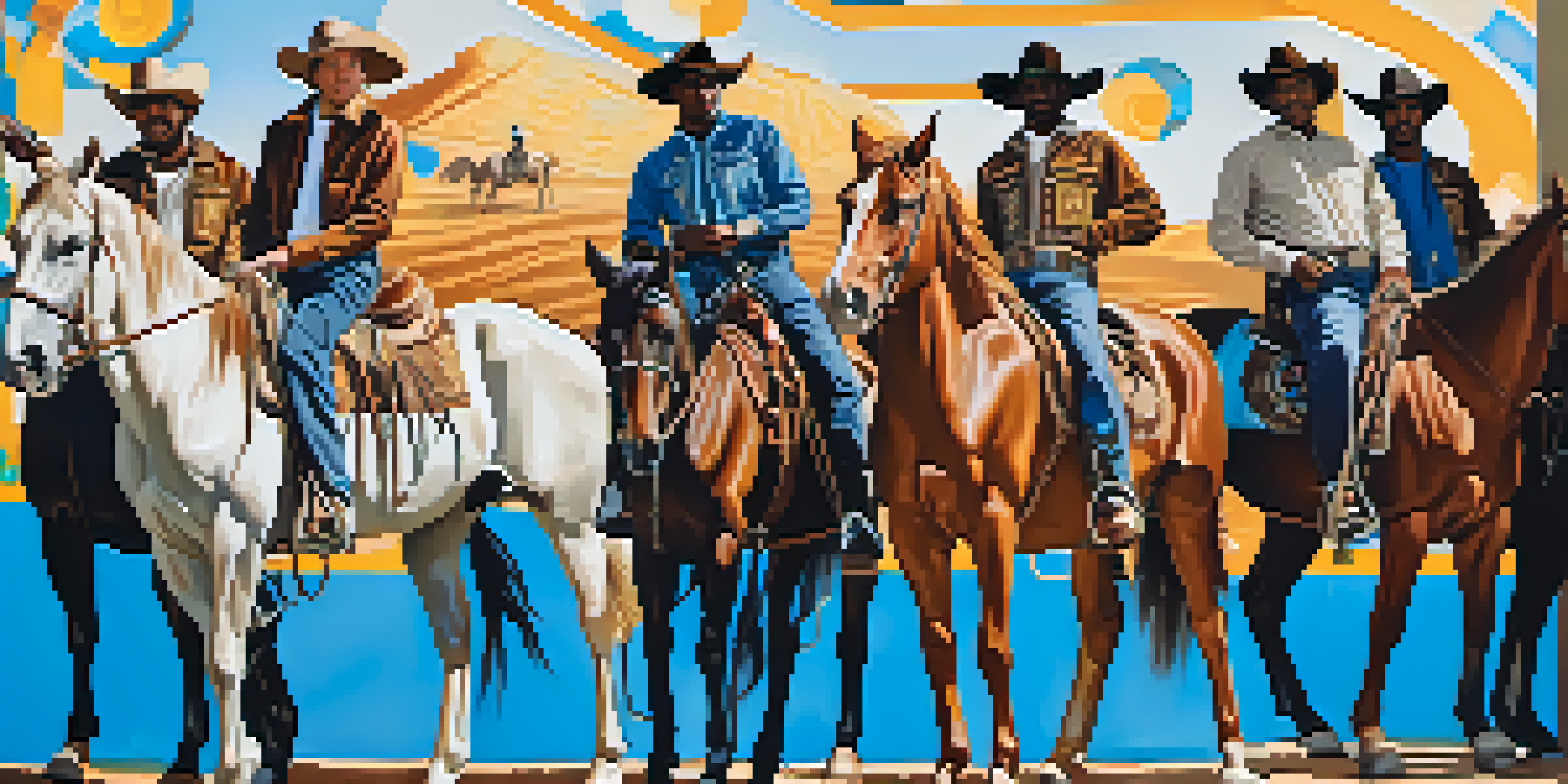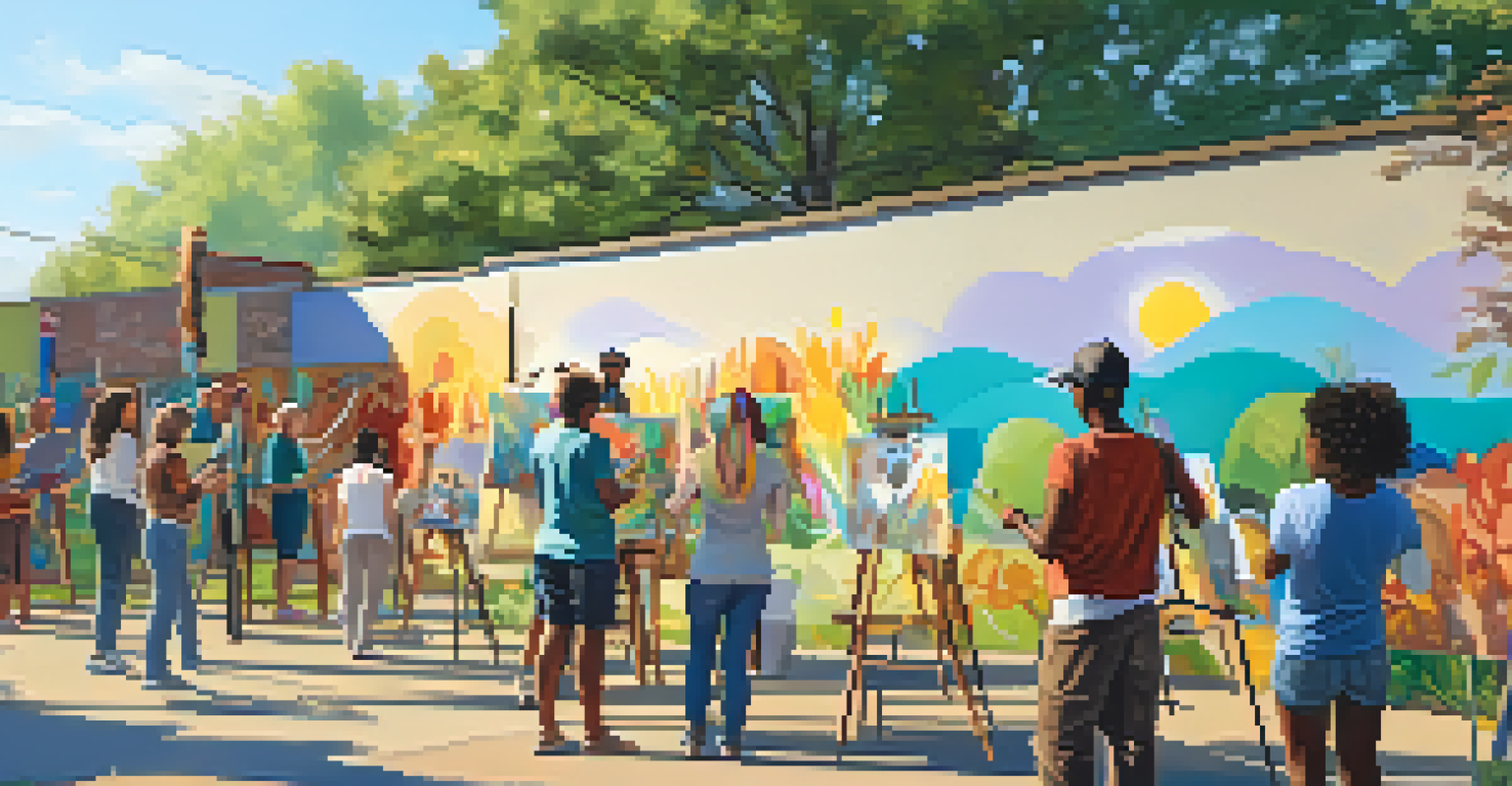Community Identity Through Art: Compton's Public Installations

The Role of Public Art in Community Identity
Public art serves as a visual language, expressing the collective identity of a community. In Compton, murals and installations reflect the city's rich history and cultural diversity. Each piece tells a story, connecting residents to their heritage and fostering a sense of pride.
Art is the most beautiful of all lies; it is the most truthful of all truths.
By showcasing local artists, these public installations also empower voices that might otherwise go unheard. They invite dialogue and participation, encouraging residents to engage with their surroundings. This interaction transforms public spaces into vibrant forums for cultural exchange.
Moreover, public art can attract visitors, enhancing the city’s image and promoting economic growth. As more people come to appreciate these artistic expressions, Compton emerges as a hub of creativity, redefining its narrative within the broader Los Angeles area.
Historical Context of Compton's Art Scene
Compton's artistic landscape has evolved significantly over the years, reflecting the city's history and challenges. From its roots in the 20th century, the community has faced social and economic obstacles that artists have often addressed through their work. This backdrop adds layers of meaning to the public installations found throughout the city.

During the 1990s, a wave of graffiti art emerged as a form of rebellion and expression among the youth. Today, this has transformed into sanctioned murals, showcasing talent while celebrating the resilience of the community. These historical layers enrich the understanding of current installations.
Public Art Shapes Community Identity
Public art serves as a visual language that expresses and strengthens the collective identity of Compton's residents.
Understanding this context is crucial for appreciating the art in Compton. It reveals how artists use their craft to comment on societal issues, creating a dialogue that resonates with both locals and visitors. This historical perspective also invites new generations to contribute to the ongoing artistic narrative.
Notable Installations and Their Impact
One standout installation in Compton is the 'Compton Cowboys' mural, which honors the city's unique equestrian culture. This artwork not only celebrates local heritage but also challenges stereotypes associated with the community. Such pieces create an inclusive narrative that resonates with diverse audiences.
Public art is a reflection of the community, a way to tell the stories that matter most to the people who live there.
Another significant installation is the 'Black Lives Matter' mural, which serves as a powerful statement on social justice. By participating in global conversations, Compton’s art installations help foster solidarity and awareness around critical issues, reinforcing the community's commitment to change.
These installations are more than just visuals; they are catalysts for conversation and reflection. They invite viewers to consider the stories behind them and inspire action within the community. As a result, these artworks become integral to Compton's identity and collective memory.
Community Involvement in Artistic Projects
Community involvement is a cornerstone of Compton's public art projects. Local residents often collaborate with artists to ensure that the installations genuinely reflect their experiences and values. This participatory approach strengthens community ties and fosters a sense of ownership over the artistic process.
Workshops and community meetings are frequently held to gather input and ideas from residents. This not only democratizes the art-making process but also educates participants about the significance of public art. Engaging the community in this way cultivates a deeper appreciation for the artworks and their impact.
Community Involvement Enhances Art
Active participation from locals in artistic projects fosters a sense of ownership and strengthens community ties.
As residents see their ideas materialize into public art, it boosts their confidence and pride in their community. This empowerment creates a ripple effect, inspiring further artistic expression and involvement. The resulting sense of unity is palpable, as the community comes together to celebrate their collective identity.
Art as a Tool for Healing and Renewal
Art has a unique ability to heal and renew communities, and Compton exemplifies this through its public installations. In the aftermath of social unrest and economic hardship, art can serve as a beacon of hope. It allows residents to process their experiences and envision a brighter future.
Murals that address themes of resilience and empowerment play a crucial role in this healing process. They provide a space for reflection and conversation, helping the community to navigate challenges together. Such artistic expressions foster a sense of belonging and solidarity.
Additionally, the act of creating art itself can be therapeutic. Community art projects often engage individuals in meaningful ways, offering outlets for creativity and self-expression. This not only contributes to personal healing but also strengthens the community as a whole.
Challenges Facing Compton's Public Art Scene
Despite the vibrancy of Compton's public art scene, challenges remain. Vandalism and lack of funding can hinder the maintenance and continuation of art projects. Ensuring that these installations remain intact and relevant requires ongoing community support and investment.
Moreover, the pressures of gentrification pose a threat to the authenticity of Compton's artistic identity. As the city evolves, there is a risk that new developments may overshadow local artists and their narratives. Balancing growth with the preservation of cultural identity is a delicate task for the community.
Art as a Catalyst for Healing
Public art in Compton provides a space for reflection and healing, helping residents navigate challenges and envision a brighter future.
These challenges underscore the importance of advocacy for public art initiatives. By rallying support from residents, local businesses, and government agencies, Compton can create a sustainable environment for its artists. This collaboration will ensure that the city's rich artistic landscape continues to thrive.
The Future of Public Art in Compton
Looking ahead, the future of public art in Compton is filled with potential. As new generations of artists emerge, they bring fresh perspectives and innovative ideas to the community. This evolution can lead to even more dynamic and inclusive art installations that speak to the diverse experiences of residents.
With increased awareness of the value of public art, there is an opportunity for more funding and resources to support artistic endeavors. Community organizations are working tirelessly to secure grants and partnerships that can bolster the local art scene. These efforts will help sustain the momentum generated by past projects.

Ultimately, the future of public art in Compton hinges on community engagement and collaboration. By fostering a culture of creativity and inclusivity, the city can continue to use art as a powerful tool for identity, healing, and growth. The journey ahead promises to be as rich and colorful as the art that defines it.